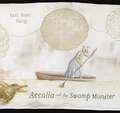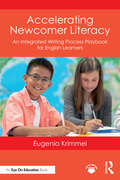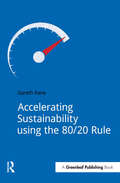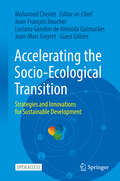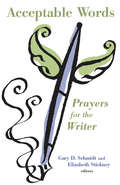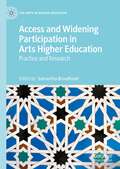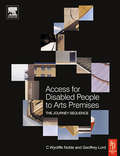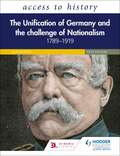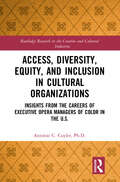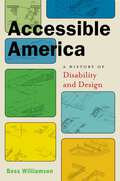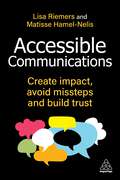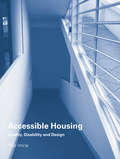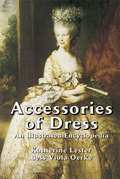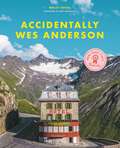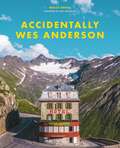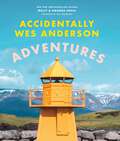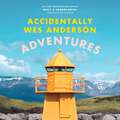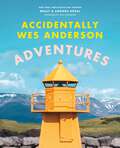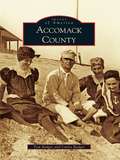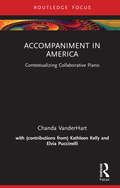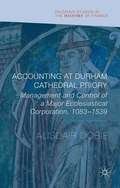- Table View
- List View
Acadiana: Louisiana's Historic Cajun Country
by Philip Gould Carl A. Brasseaux"Acadiana" summons up visions of a legendary and exotic world of moss-draped cypress, cocoa-colored bayous, subtropical wildlife, and spicy indigenous cuisine. The ancestral home of Cajuns and Creoles, this twenty-two-parish area of south Louisiana encompasses a broad range of people, places, and events. In their historical and pictorial tour of the region, author Carl A. Brasseaux and photographer Philip Gould explore in depth this fascinating and complex world.As passionate documentarians of all things Cajun and Creole, Brasseaux and Gould delve into the topography, culture, and economy of Acadiana.In two hundred color photographs of architecture, landscapes, wildlife, and artifacts, Gould portrays the rich history still visible in the area, while Brasseaux's engagingly written narrative covers the eighteenth- and nineteenth-century story of settlement and development in the region. Brasseaux brings the story up to date, recounting devastating hurricanes and coastal degradation.From living-history attractions such as Vermilionville, the Acadian Village, and Longfellow-Evangeline State Park to music venues, festivals, and crawfish boils, Acadiana depicts a resilient and vibrant way of life and presents a vivid portrait of a culture that continues to captivate, charm, and endure.For all those who want to explore these people and this place, Brasseaux and Gould have provided an insightful written and visual history.
Accalia and the Swamp Monster
by Kelli Scott KelleyAs the author and artist of a heroine's surreal journey through a haunting southern landscape, Kelli Scott Kelley reveals the mastery of her craft and the strong narrative ability of her artwork. Borrowing from Roman mythology, Jungian analysis, and the psychology of fairy tales, Kelley presents a story of family dysfunction, atonement, and transformation.Reproductions of her artwork -- mixed-media paintings executed on repurposed antique linens -- punctuate the tale of Accalia, who is tasked with recovering the arms of her father from the belly of the swamp monster. Visually and metaphorically, Accalia's odyssey enchants and displaces as Kelley delicately balances the disquieting with the familiar. Rich in symbolism and expertly composed, Accalia and the Swamp Monster pulls readers into the physical realm through Kelley's chimerical imagery and then pushes them towards the inner world of the subconscious. To that end, Kelley's story is accompanied by essays from Jungian analyst Constance Romero and art historian Sarah Bonner.A culmination of nearly a decade of work, introspection, and research, Accalia and the Swamp Monster is both an entrancing display of Kelley's art and an affirmation of the transformative power of fairy tales.
Accelerating Newcomer Literacy: An Integrated Writing Process Playbook for English Learners
by Eugenia KrimmelThis book supports educators in teaching academic writing skills to Newcomer English Learners (ELs) who are just beginning their English language learning journey.Newcomer ELs typically have minimal familiarity with the English alphabet, which can be an obstacle for them learning writing, phonics, and spelling in English. Drawing on research and classroom‑tested methods, this book provides teachers practical strategies to help Newcomers start writing earlier, mastering letter-sound correspondence, and gaining confidence to write their thoughts in English. Readers will learn how to seamlessly integrate EL-targeted strategies and personalized literacy instruction into writing workshops to accelerate Newcomer’s acquisition of English phonics, spelling, and writing skills. These adaptable strategies also benefit World Language teachers seeking effective ways to teach writing and literacy to beginners on any language learning journey.Built on the author’s instructional coaching expertise and observations of field testing by practicing teachers, this is an excellent resource for English as a Second Language (ESL) educators and instructional coaches to promote faster and better literacy acquisition for their Newcomers and other beginner language learners.
Accelerating Sustainability Using the 80/20 Rule
by Gareth KaneAre your sustainability efforts making as much impact as they could be?With our collective way of life rubbing up against the natural limits of the planet, it does not take a genius to see that it is time to scrape the mud off our boots and find a shorter, smarter path towards sustainability – a way to maximize our effectiveness and inspire leaps forward in sustainability, rather than incremental steps. The 80/20 rule says that, in many situations, a small number of inputs determine the vast majority of our desired results. If we identify these “vital few” inputs in our sustainability efforts, and focus on them, we can maximize our effectiveness and accelerate progress rapidly. This book will help you to think about sustainability from an 80/20 perspective with practical applications for: product and service development; supply chains; materiality, indicators and quantitative analysis; waste, energy efficiency, water conservation and transport; employee engagement and sustainability strategy. If you want to focus on what works, deliver better results, waste less time on “switch it off” stickers and ineffective “standard practice” and start making a real difference, then this book is for you!
Accelerating the Socio-Ecological Transition: Strategies and Innovations for Sustainable Development
by Mohamed Cheriet Jean-François Boucher Luciana Gondim de Almeida Guimarães Jean-Marc FrayretThis book explores the key principles and challenges of implementing the socio-ecological transition, with a particular focus on Quebec, Canada. It addresses these issues from both research and educational perspectives, offering actionable strategies to accelerate this transition across the province's various economic sectors. The book's structure aligns with the CIRODD (Interdisciplinary Research Center for Operationalization of Sustainable Development) scientific program, organized into two major sections and 11 thematic areas. The objective is to showcase the latest advancements in socio-ecological transition, drawing on a decade of research contributions from CIRODD. This book edition will highlight key innovations, emerging trends, and impactful solutions that have shaped the field, demonstrating CIRODD&’s pivotal role in driving sustainable transformation. Section 1 delves into practical interventions and strategies for citizen engagement, exploring transition initiatives, urban planning, and collaborative knowledge-building models. It brings together theoretical, practical, and experiential insights, emphasizing the vital role of research and the arts in facilitating the socio-ecological transition. Section 2 equips readers with the necessary tools to support this transition, offering models and methods for analyzing complex systems. It highlights innovative digital approaches for developing circular and sustainable business models. This is an open access book.
Acceptable Words: Prayers for the Writer
by Gary Schmidt Elizabeth StickneyAcceptable Words offers prayers that correspond with each stage of the writer's work -- from finding inspiration to penning the first words to "offering it to God" at completion. Gary Schmidt and Elizabeth Stickney, experienced writers themselves, introduce each chapter of prayers with pithy pastoral reflections that will encourage writers in their craft.This welcome spiritual resource for writers includes both ancient and contemporary poems and prayers -- some of which were written especially for this volume. A thoughtful gift for any writer, Acceptable Words will accompany writers on their spiritual journey, lending words of praise and petition specifically crafted to suit their unique vocation.Watch the trailer:
Access and Widening Participation in Arts Higher Education: Practice and Research (The Arts in Higher Education)
by Samantha BroadheadThis volume brings together a range of practitioners, managers, and researchers who work within the field of arts higher education to reflect on strategies to increase access and widening participation (WP). The issues presented in this book are situated within a wider global context where countries are seeking greater harmonisation of higher education as students and workers become more mobile, crossing international borders. The chapter authors address various issues within higher education institutions from a WP context, including areas such as creative writing, music, art and design. In exploring these issues the editor and her chapter authors seek to answer how those teaching in arts higher education can promote the value and quality of their work while ensuring fair access and wide participation for all.
Access for Disabled People to Arts Premises: The Journey Sequence
by Geoffrey Lord C Wycliffe NobleIllustrating actual building design solutions that have been created to improve accessibility for disabled patrons and performers, the 'Journey Sequence' outlines the best examples of design innovation produced in response to new and upcoming legislation.A knowledge of how to design for the disabled can be crucial in winning contracts and having designs accepted. This book shows how the practical implications have already been successfully approached.Covering the whole sequence from parking, to entry, and including details of facilities for the visually and hearing impaired users, advice is given on the methods designers should use in assessing the requirements of disabled people. This is not a publication giving theoretical prescription but rather an illustrated record of achievements in buildings of all sizes where proper access to the disabled has been created. It includes 14 case studies and examples that illustrate the diverse ways that accessibility has been incorporated into arts buildings throughout the UK. This includes Cinemas, Theatres, Concert Halls, Opera Houses, Museums and Libraries. The author team highlights specific design details that are particularly unique, to stimulate the reader and show that creating better accessibility for the disabled both demands and creates innovative design.
Access to History: The Unification of Germany and the Challenge of Nationalism 1789–1919, Fifth Edition
by Vivienne SandersExam board: Pearson Edexcel; OCRLevel: AS/A-levelSubject: HistoryFirst teaching: September 2015First exams: Summer 2016 (AS); Summer 2017 (A-level)Put your trust in the textbook series that has given thousands of A-level History students deeper knowledge and better grades for over 30 years.Updated to meet the demands of today's A-level specifications, this new generation of Access to History titles includes accurate exam guidance based on examiners' reports, free online activity worksheets and contextual information that underpins students' understanding of the period.- Develop strong historical knowledge: In-depth analysis of each topic is both authoritative and accessible- Build historical skills and understanding: Downloadable activity worksheets can be used independently by students or edited by teachers for classwork and homework- Learn, remember and connect important events and people: An introduction to the period, summary diagrams, timelines and links to additional online resources support lessons, revision and coursework- Achieve exam success: Practical advice matched to the requirements of your A-level specification incorporates the lessons learnt from previous exams- Engage with sources, interpretations and the latest historical research: Students will evaluate a rich collection of visual and written materials, plus key debates that examine the views of different historians
Access to History: The Unification of Germany and the Challenge of Nationalism 1789–1919, Fifth Edition
by Vivienne SandersExam board: Pearson Edexcel; OCRLevel: AS/A-levelSubject: HistoryFirst teaching: September 2015First exams: Summer 2016 (AS); Summer 2017 (A-level)Put your trust in the textbook series that has given thousands of A-level History students deeper knowledge and better grades for over 30 years.Updated to meet the demands of today's A-level specifications, this new generation of Access to History titles includes accurate exam guidance based on examiners' reports, free online activity worksheets and contextual information that underpins students' understanding of the period.- Develop strong historical knowledge: In-depth analysis of each topic is both authoritative and accessible- Build historical skills and understanding: Downloadable activity worksheets can be used independently by students or edited by teachers for classwork and homework- Learn, remember and connect important events and people: An introduction to the period, summary diagrams, timelines and links to additional online resources support lessons, revision and coursework- Achieve exam success: Practical advice matched to the requirements of your A-level specification incorporates the lessons learnt from previous exams- Engage with sources, interpretations and the latest historical research: Students will evaluate a rich collection of visual and written materials, plus key debates that examine the views of different historians
Access, Diversity, Equity and Inclusion in Cultural Organizations: Insights from the Careers of Executive Opera Managers of Color in the US (Routledge Research in the Creative and Cultural Industries)
by Antonio C. CuylerAnalyzing the lack of diversity among opera executives, this book examines the careers of executive opera managers of color in the U.S. By interrogating the impact of race on arts managers’ careers, the author contemplates how opera might attract and retain more racially diverse arts managers to ensure its future.With a focus on the U.S., research is contextualized via qualitative data to explore, enhance, and institutionalize access, diversity, equity, and inclusion (ADEI) in the opera industry. In a revealing series of expert-conducted interviews, the author poses illuminating questions, such as: what if an inability to recruit and retain diverse executives is the primary source of opera’s challenges? if more racially diverse opera executives existed, would the art form persist in struggling to find its place in contemporary society? from where will the next generation of diverse opera managers emerge? As the magnitude of the global diversity problem grows within the creative and cultural industries, this book serves as a guide for Arts Management practitioners and students who may view their class, different ability, ethnicity, gender, race, or sexual orientation as a liability in their pursuit of executive careers.
Accessible America: A History of Disability and Design (Crip #2)
by Bess WilliamsonA history of design that is often overlooked—until we need itHave you ever hit the big blue button to activate automatic doors? Have you ever used an ergonomic kitchen tool? Have you ever used curb cuts to roll a stroller across an intersection? If you have, then you’ve benefited from accessible design—design for people with physical, sensory, and cognitive disabilities. These ubiquitous touchstones of modern life were once anything but. Disability advocates fought tirelessly to ensure that the needs of people with disabilities became a standard part of public design thinking. That fight took many forms worldwide, but in the United States it became a civil rights issue; activists used design to make an argument about the place of people with disabilities in public life.In the aftermath of World War II, with injured veterans returning home and the polio epidemic reaching the Oval Office, the needs of people with disabilities came forcibly into the public eye as they never had before. The US became the first country to enact federal accessibility laws, beginning with the Architectural Barriers Act in 1968 and continuing through the landmark Americans with Disabilities Act in 1990, bringing about a wholesale rethinking of our built environment. This progression wasn’t straightforward or easy. Early legislation and design efforts were often haphazard or poorly implemented, with decidedly mixed results. Political resistance to accommodating the needs of people with disabilities was strong; so, too, was resistance among architectural and industrial designers, for whom accessible design wasn’t “real” design.Bess Williamson provides an extraordinary look at everyday design, marrying accessibility with aesthetic, to provide an insight into a world in which we are all active participants, but often passive onlookers. Richly detailed, with stories of politics and innovation, Williamson’s Accessible America takes us through this important history, showing how American ideas of individualism and rights came to shape the material world, often with unexpected consequences.
Accessible Communications: Create Impact, Avoid Missteps and Build Trust
by Lisa Riemers Matisse Hamel-NelisReady to build credibility and optimize your communications for real business impact? Accessible Communications is a practical guide designed for mid-career professionals seeking to develop effective, inclusive messaging that aligns with evolving regulations and business goals. Written by award-winning communications consultants Lisa Riemers and Matisse Hamel-Nelis, this book offers clear models and frameworks to help you apply accessibility principles confidently across emails, documents, videos and social media. With real-world examples and actionable tools, it empowers you to implement strategies that expand reach, protect reputation and enhance career growth.You'll learn how to:- Use proven frameworks to build accessible communications strategically - Apply practical tools that optimize messaging across multiple formats- Understand evolving legislation and its impact on communications- Develop skills to increase audience engagement and trustThis guide supports your career development by helping you create communications that comply with regulations and drive business success.Themes include: Accessibility and inclusivity, Communication strategy and frameworks, Practical application and tools, Career development and credibility building, Regulatory compliance and business impact
Accessible Housing: Quality, Disability and Design
by Rob ImrieConsidering the interrelationships between disability and housing design with a focus on the role of policy in addressing the housing needs of disabled people, this book sets out some of the broader debates about the nature of housing, quality and design. In what ways are domestic design and architecture implicated in inhibiting or facilitating mobility and movement of people? What is the nature of government regulation and policy in relation to the design of home environments? The author addresses these questions, and brings a range of approaches to accessible design in housing to the forefront of debate, assessing how far policies and practices are equal to the challenge of creating accessible and desirable home environments.
Accessories of Dress: An Illustrated Encyclopedia
by Bess Viola Oerke Katherine LesterDrawing upon a vast number of historical sources, the authors of this useful reference have created an entertaining account of the forms of personal adornment men and women have used throughout the ages to enhance their wearing apparel. From hats, veils, wigs, and cosmetics, to cravats, shawls, shoes, and gloves, to walking sticks, handbags, fans, and furs, the engaging commentary displays the humor and personal charm of the many-sided story of accessorized apparel. 644 figures and 59 plates.
Accidentally Wes Anderson
by Wally KovalA visual adventure of Wes Anderson proportions, authorized by the legendary filmmaker himself: stunning photographs of real-life places that seem plucked from the just-so world of his films, presented with fascinating human stories behind each façade. Accidentally Wes Anderson began as a personal travel bucket list, a catalog of visually striking and historically unique destinations that capture the imagined worlds of Wes Anderson. <P><P> Now, inspired by a community of more than one million Adventurers, Accidentally Wes Anderson tells the stories behind more than 200 of the most beautiful, idiosyncratic, and interesting places on Earth. This book, authorized by Wes Anderson himself, travels to every continent and into your own backyard to identify quirky landmarks and undiscovered gems: places you may have passed by, some you always wanted to explore, and many you never knew existed. Fueled by a vision for distinctive design, stunning photography, and unexpected narratives, Accidentally Wes Anderson is a passport to inspiration and adventure. Perfect for modern travelers and fans of Wes Anderson's distinctive aesthetic, this is an invitation to look at your world through a different lens. <P><P><b>A New York Times Bestseller</b>
Accidentally Wes Anderson
by Wally KovalWes Anderson's beloved films announce themselves through a singular aesthetic - one that seems too vivid, unique, and meticulously constructed to possibly be real. Not so - in Accidentally Wes Anderson, Wally Koval collects the world's most Anderson-like sites in all their faded grandeur and pop-pastel colours, telling the story behind each stranger than-fiction-location. Based on the viral online phenomenon and community of the same name, Accidentally Wes Anderson celebrates the unique aesthetic that millions of Anderson fans love - capturing the symmetrical, the atypical, the unexpected, the vibrantly patterned, and distinctively coloured in arresting photographs from around the world. Authorised by Wes Anderson himself, and appealing to the millions who love his films, this book is also for fans of Cabin Porn and Van Life - and avid travellers and aspiring adventurers of all kinds.
Accidentally Wes Anderson - Adventures: Includes an Exclusive Foreword by Wes Anderson
by Wally Koval Amanda Koval*EXCLUSIVE FOREWORD BY WES ANDERSON*Accidentally Wes Anderson is back with 200 brand new, mind-bendingly beautiful destinations for your bucket list, and the fascinating stories behind each location. · You'll visit the 'post office at the end of the world' in Tierra del Fuego - and meet the mustachioed letter carrier who, in his free time, runs an anarchist island micronation called Redonda.· You'll travel to a town in the Arctic Circle where cats are not allowed, humans cannot be buried, and a primary attraction is a doomsday vault containing the recipe for the Oreo cookie.· And you might just make a stop in lesser-known Jincumbilly, Australia (where there are more platypuses than people).Full of incredible photos of real-life locations that look plucked from the world of Wes Anderson, this book is all about Adventures big and small, everyday and extraordinary, here and way over there. You'll meet some out-of-this-world characters and be left with travel, design and architectural inspiration beyond your imagination. No passport necessary!
Accidentally Wes Anderson - Adventures: Includes an Exclusive Foreword by Wes Anderson (Accidentally Wes Anderson)
by Wally Koval Amanda Koval*EXCLUSIVE FOREWORD BY WES ANDERSON*Accidentally Wes Anderson is back with 200 brand new, mind-bendingly beautiful destinations for your bucket list, and the fascinating stories behind each location. · You'll visit the 'post office at the end of the world' in Tierra del Fuego - and meet the mustachioed letter carrier who, in his free time, runs an anarchist island micronation called Redonda.· You'll travel to a town in the Arctic Circle where cats are not allowed, humans cannot be buried, and a primary attraction is a doomsday vault containing the recipe for the Oreo cookie.· And you might just make a stop in lesser-known Jincumbilly, Australia (where there are more platypuses than people).Full of incredible photos of real-life locations that look plucked from the world of Wes Anderson, this book is all about Adventures big and small, everyday and extraordinary, here and way over there. You'll meet some out-of-this-world characters and be left with travel, design and architectural inspiration beyond your imagination. No passport necessary!
Accidentally Wes Anderson: Adventures (Accidentally Wes Anderson)
by Wally Koval Amanda KovalAdventure awaits in this new visual odyssey from Accidentally Wes Anderson, taking readers on stunning trips to every continent and sharing oddly moving human tales along the way. For lovers of travel, design, and exploration, AWA presents a brand-new collection of real-world places that seem plucked from the films of Wes Anderson, and the stories that bring each location to life. You&’ll venture to Antarctica through the treacherous Drake Passage, make a stop in lesser-known Jincumbilly, Australia (where platypuses outnumber people), discover the bridge in Wisconsin that went to nowhere, and drop into the most peculiar umbrella shop in London. But adventure means nothing without someone to tell the tale. You&’ll meet the father of American skydiving, who created the officially-sanctioned center of Earth—a California town with a population of two. You&’ll visit the &“post office at the end of the world&”—and meet its mustachioed letter carrier, who runs an anarchist island nation in his free time. And you&’ll travel to a town in the Arctic Circle where cats are prohibited, humans may not be buried, and doomsday vaults hold all we need to survive an apocalypse—including the secret recipe for the Oreo cookie. Authorized by the legendary filmmaker himself, Accidentally Wes Anderson Adventures reminds us that the world is ours to explore.
Accomack County
by Curtis Badger Tom BadgerAquarena Springs was the culmination of a dream shared by two men: Arthur Birch (A. B.) Rogers and his son Paul J. Rogers. The Spring Lake Park Hotel opened at the headwaters of the San Marcos River in 1929. Soon, Aquarena Springs would become one of the premier tourist destinations in the Southwest. Attractions such as glass bottom boats, a Swiss sky ride, Texana Village, and the world's only submarine theater delighted hundreds of thousands of visitors each year. From special events like the underwater wedding featured in Life magazine to the daily antics of nationally known Ralph the Swimming Pig, Aquarena provided entertainment and created lifelong memories for countless families. In recent years, under the auspices of the River Systems Institute at Texas State University, Aquarena has become an important center for environmental education and research.
Accompaniment in America: Contextualizing Collaborative Piano
by Chanda VanderHartPiano accompaniment, or collaborative piano, is an invisibilized force driving classical music. This hybrid study, combining text and multimedia, explores its history, evolution, and transformation into a recognized academic discipline through archival research, expert interviews, and digital resources.This hybrid publication delves into the origins and institutionalization of collaborative piano, tracing its development from the early 20th century to the present day. It highlights a profession often overlooked, introduces pioneering figures including Gwendolyn Koldofsky, and maps the establishment of over 100 degree-granting programs across North America. With an interactive data visualization tool, QR codes linking to compelling first-hand accounts, and extensive archival materials, it offers a vivid, multidimensional journey through the field’s past and present. By contextualizing the profession through analysis of its pedagogical, gendered, and institutional dynamics, this work seeks to foster a deeper understanding of collaborative piano’s past, present, and future, while advocating for its recognition and advancement.Accompaniment in America: Contextualizing Collaborative Piano is essential reading and viewing for musicians, music students, educators, scholars, and administrators, as well as anyone interested in the intersection of collaborative piano history, performance practice, and academia. It is a valuable resource for both students and professionals seeking to understand the complexities of a field still broadly misunderstood and its pivotal role in classical music.
Accounting at Durham Cathedral Priory: Management And Control Of A Major Ecclesiastical Corporation 1083-1540 (Palgrave Studies in the History of Finance)
by Alisdair DobieThis study utilizes the rich archives which survive at Durham Cathedral to examine the way in which accounting methods and systems were adopted and adapted to manage income and expenses, assets and liabilities in changing economic environments.
Accounting for Construction: Frameworks, Productivity, Cost and Performance
by Rick Best Jim MeikleAccounting for Construction follows on from Measuring Construction, edited by the same team. It extends the coverage of some of the material in the first volume and expands the range of related topics to include, inter alia, shadow economies, accounting for informal construction and the treatment of the built environment sector in national accounts. Taken together, the two volumes collate a range of topics that are only addressed, if addressed at all, in occasional academic papers and the publications of bodies such as national statistical offices and the World Bank. Accounting for Construction presents international examples from the UK, Australia and New Zealand and from both academic and professional contributors. This book is essential reading for all researchers and professionals interested in construction economics, construction management, and anyone interested in how the construction industry affects the global economy in ways previously under-represented in the literature.
Accounting for Sustainability
by Gunnar RimmelThis book provides a broad overview of how sustainability reporting has grown, how it is used now, and where it is heading.Daily, we encounter concepts such as corporate social responsibility (CSR); sustainability reporting; sustainability accounting; environmental reports; corporate citizenship or environmental management systems; or Environmental, Social and Governance (ESG) disclosures. Accounting for Sustainability decodes this terminology by offering an accessible introduction that explores sustainability reporting from both internal and external perspectives. It begins with an overview of key terms and theories, followed by chapters on financial management, sustainability standards, accounting communication, and capital markets. This new edition has been fully revised and expanded with four new chapters, including coverage of the EU’s Corporate Sustainability Reporting Directive (CSRD), European Sustainability Reporting Standards (ESRS), and the global efforts of the International Sustainability Standards Board (ISSB). It also includes critical reflections on digitalisation, standard-setting, and assurance.With learning outcomes and study questions embedded in each chapter, this book will be of great interest to students of sustainability reporting and accounting, as well as practitioners taking related professional accreditations.

